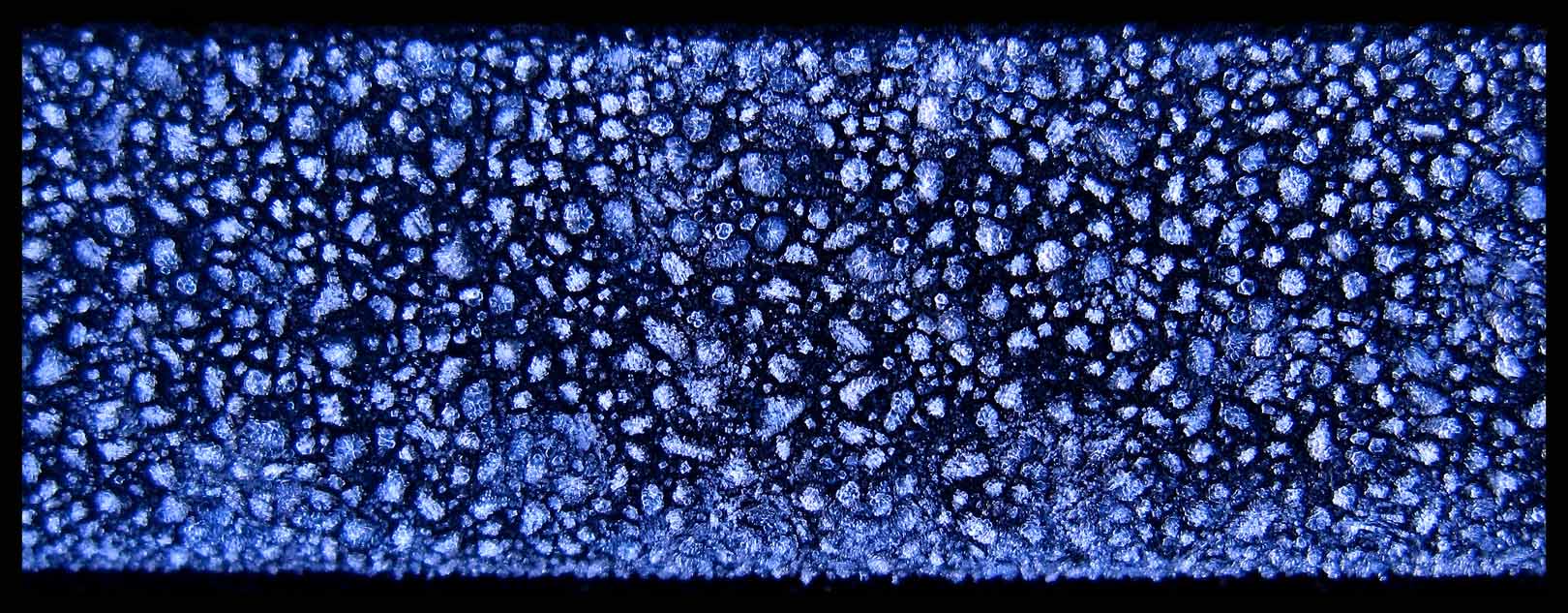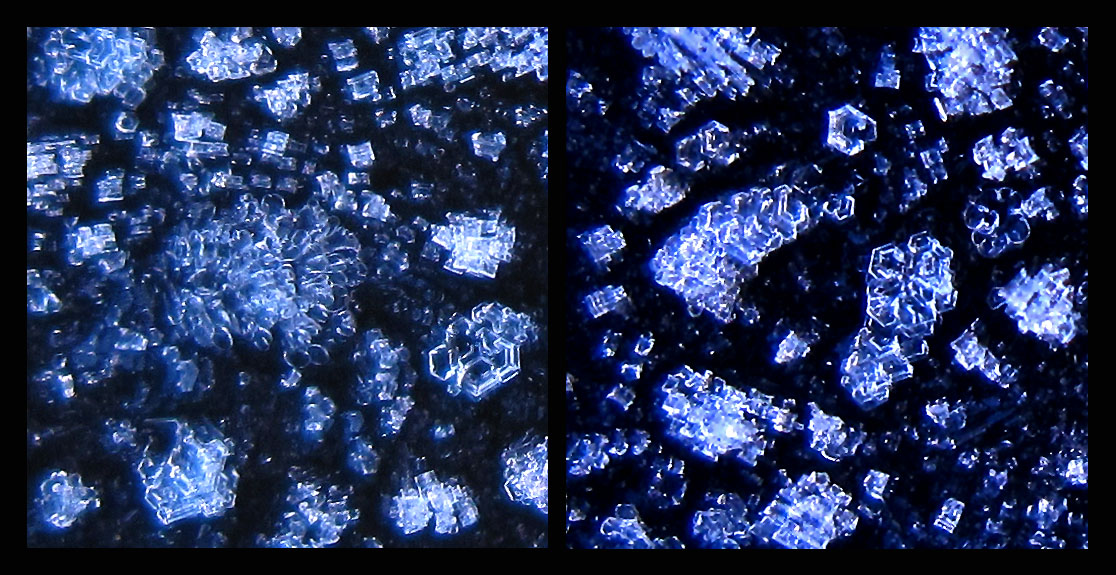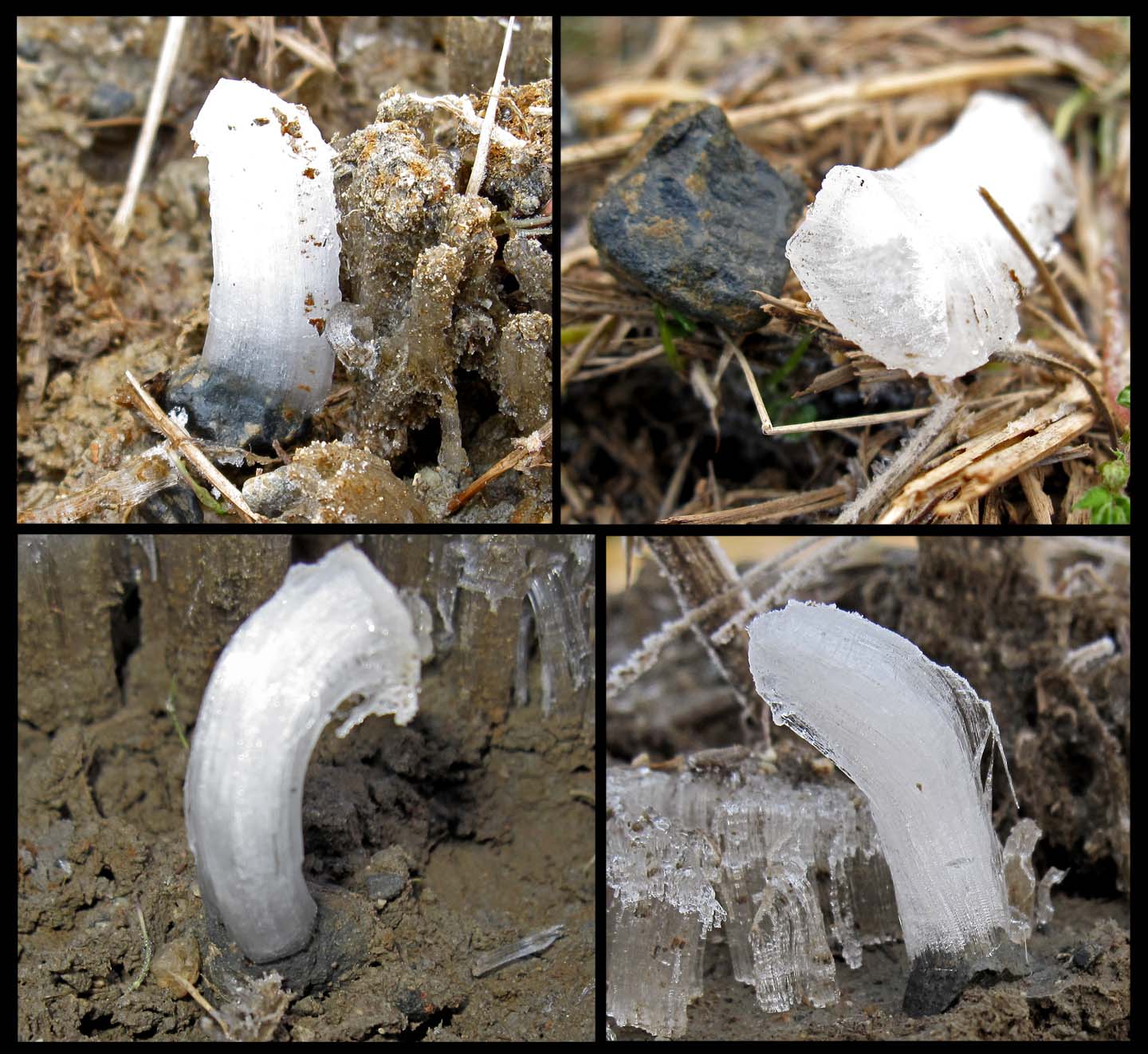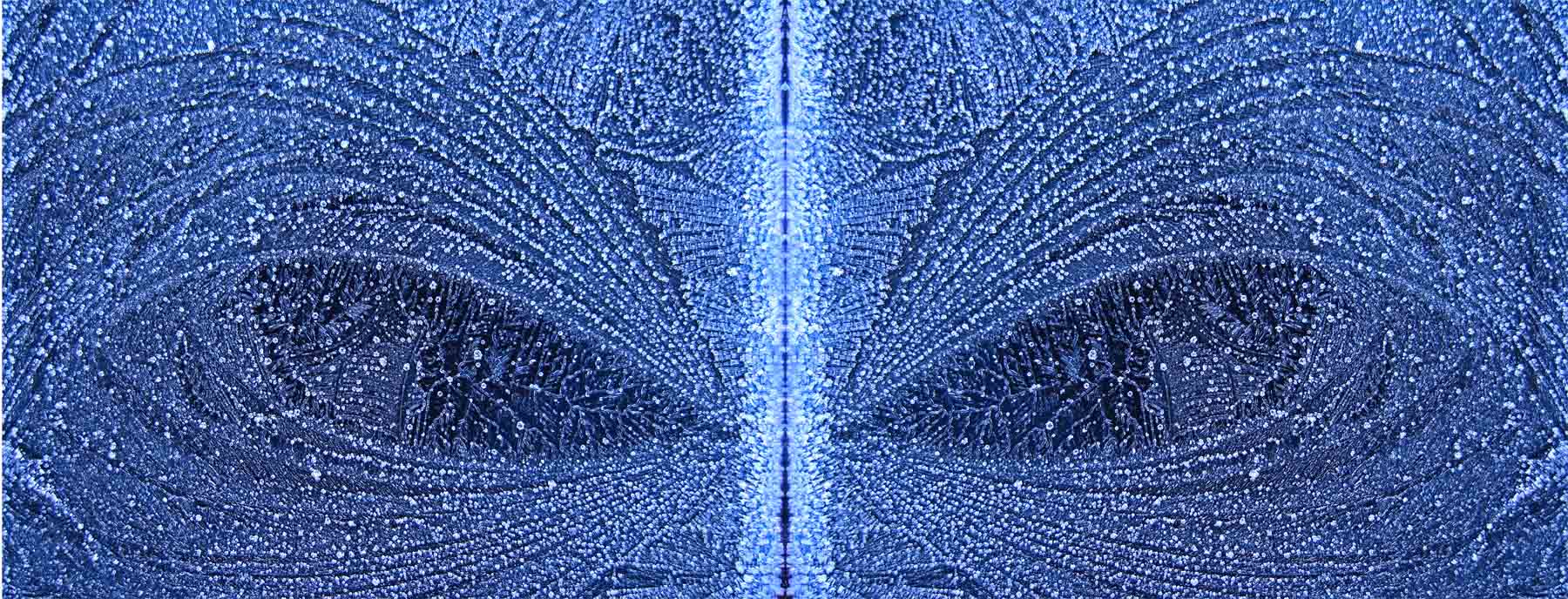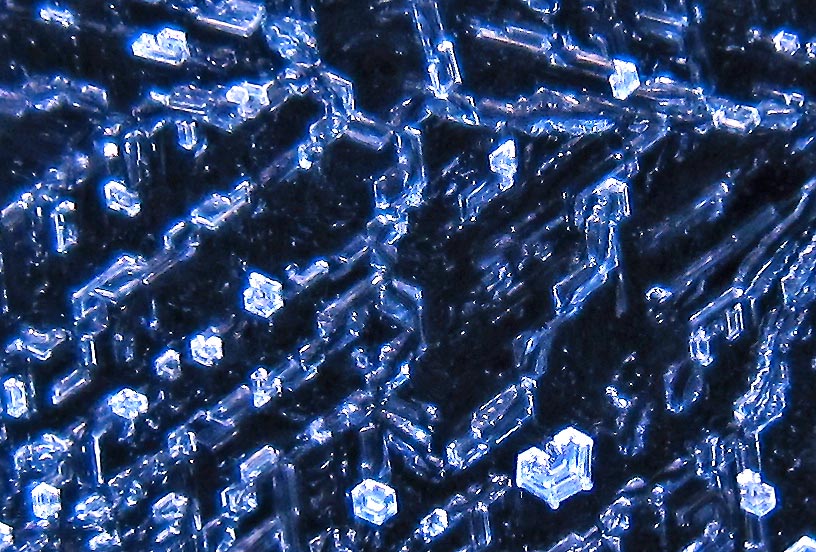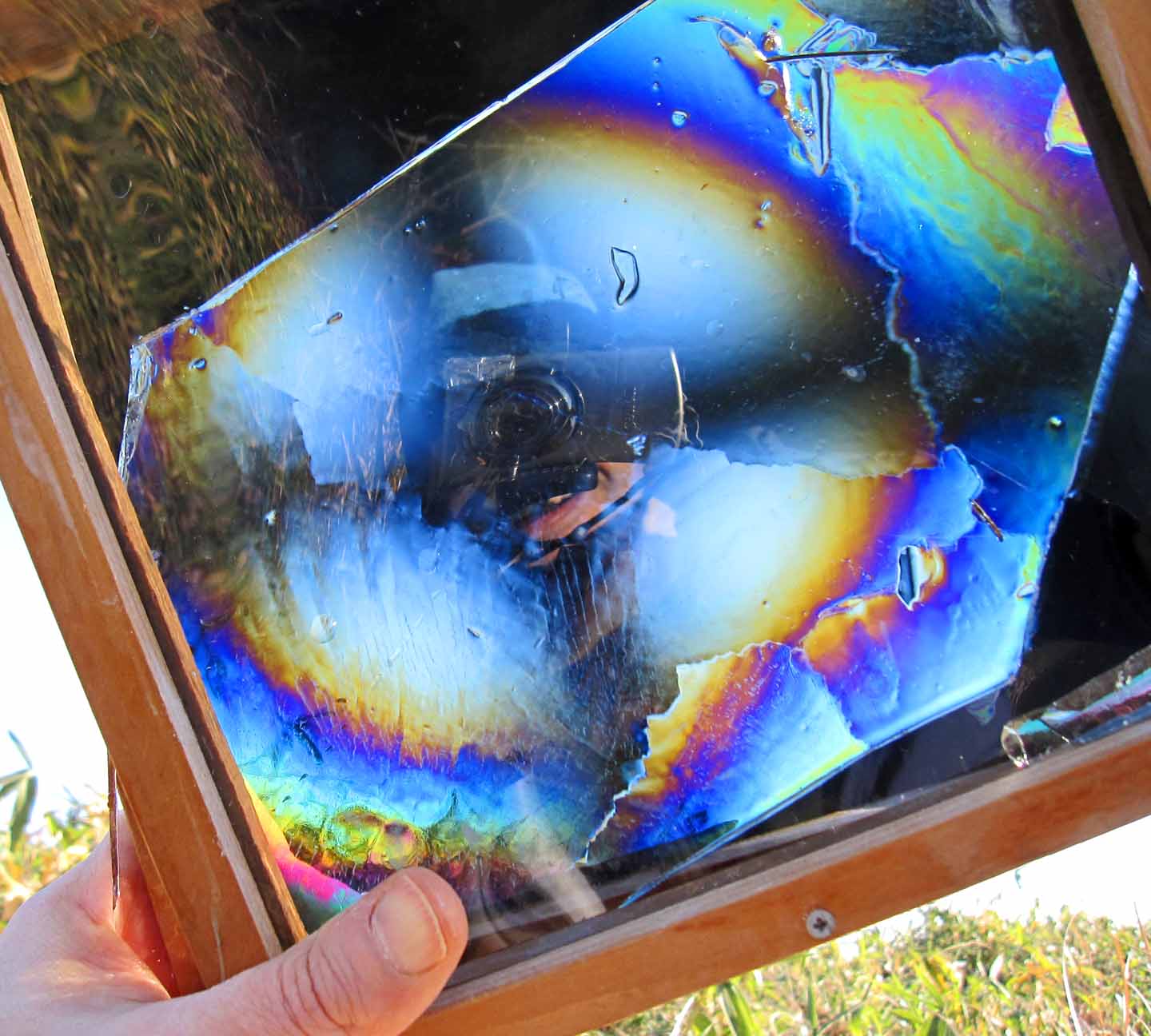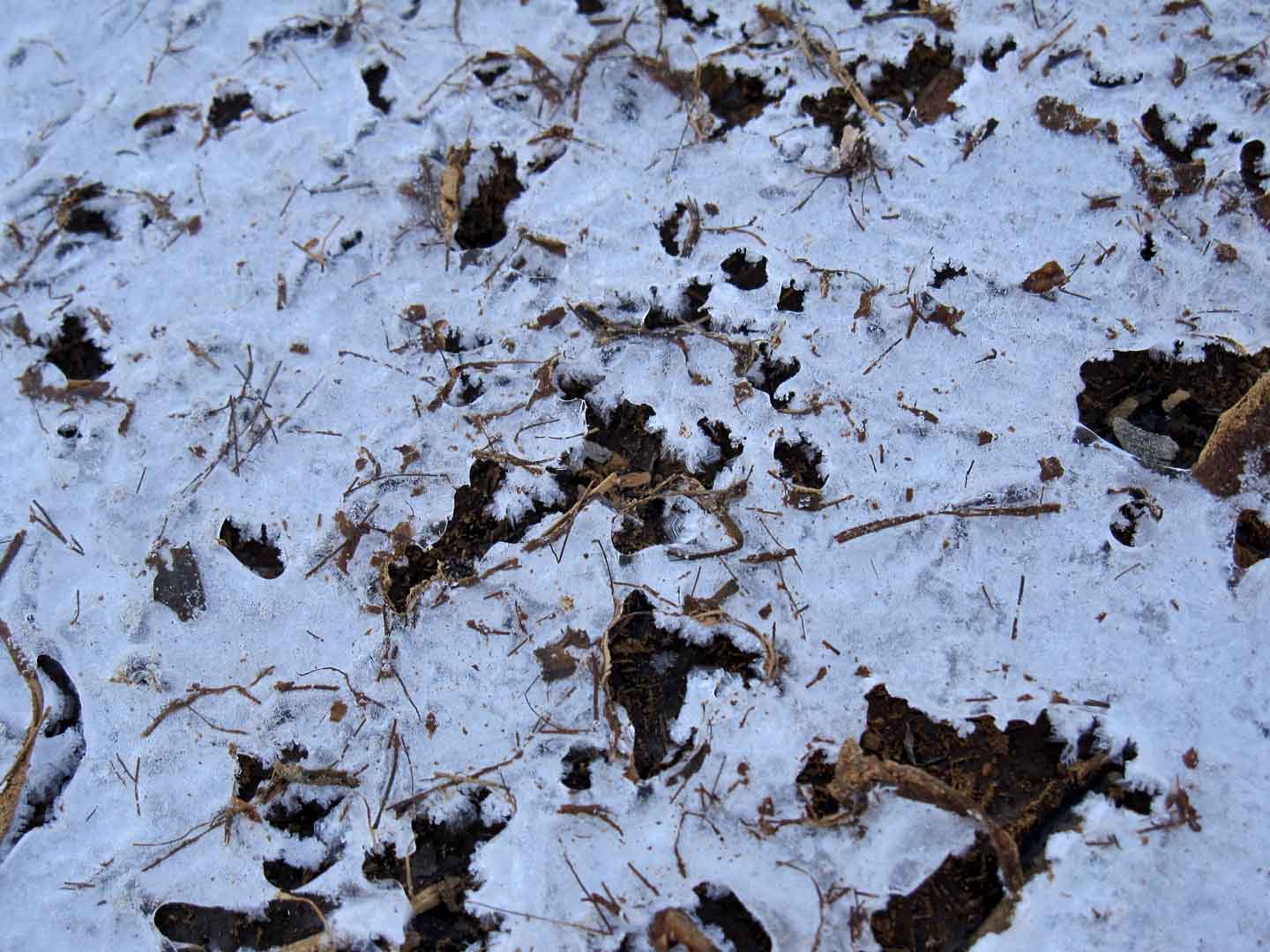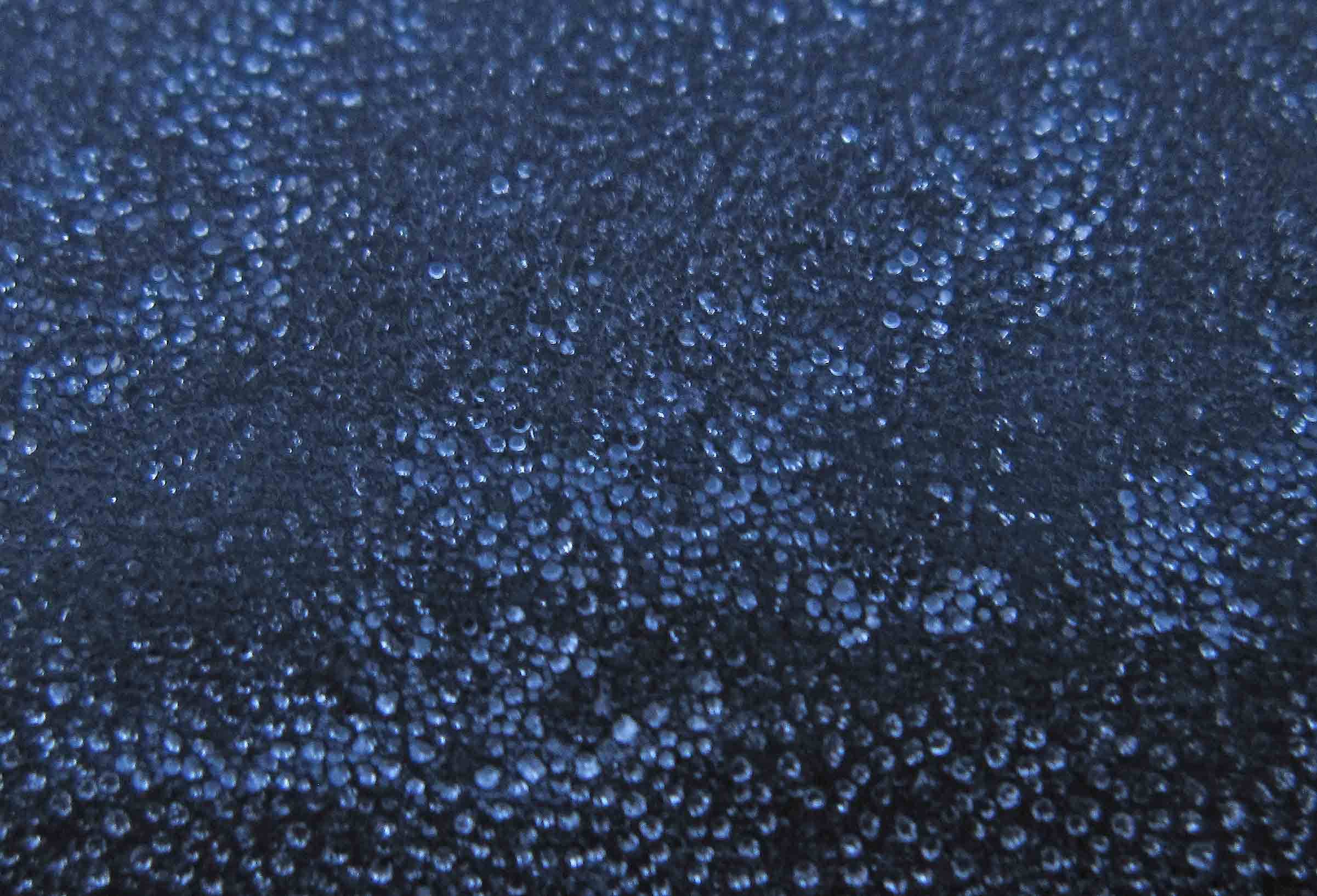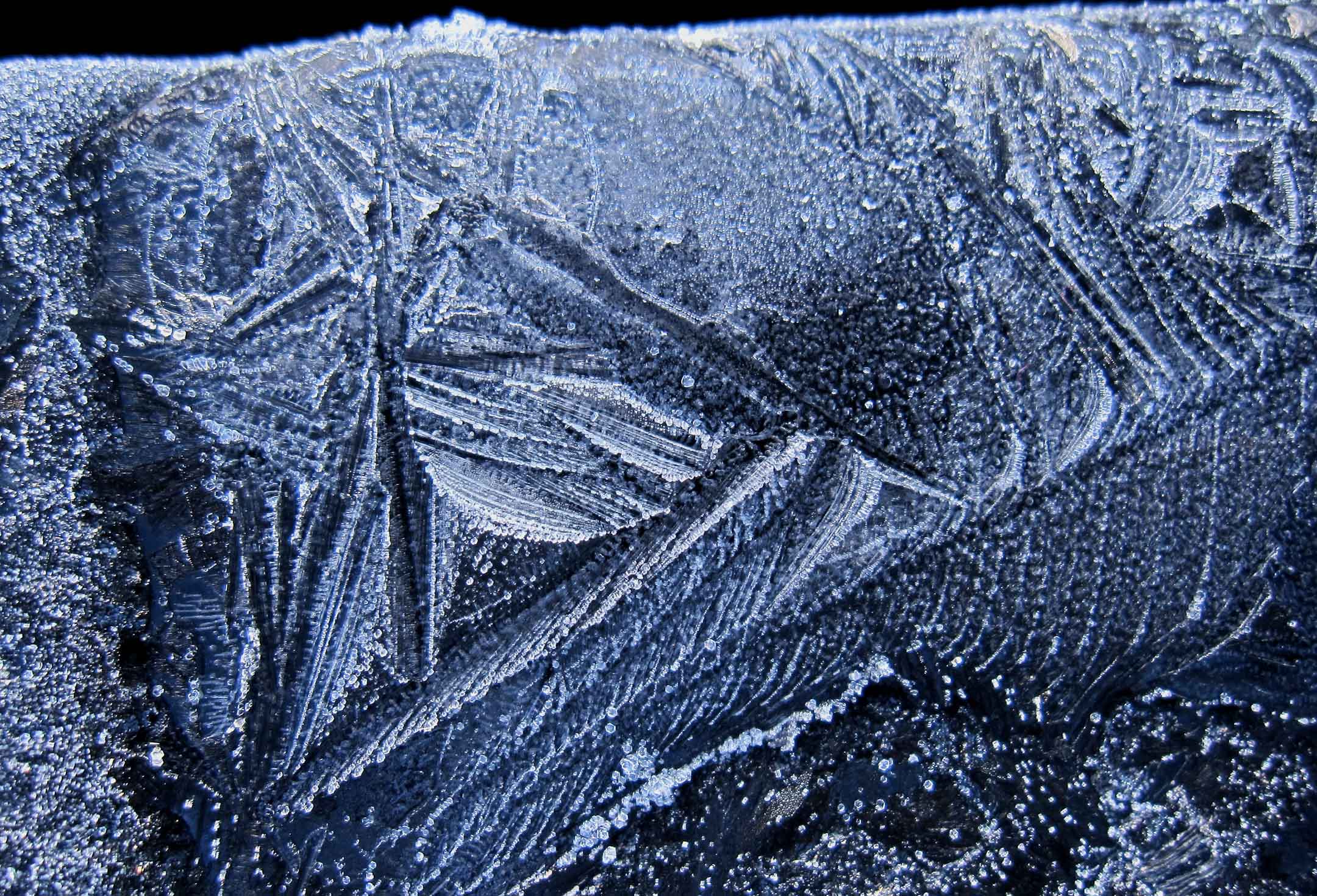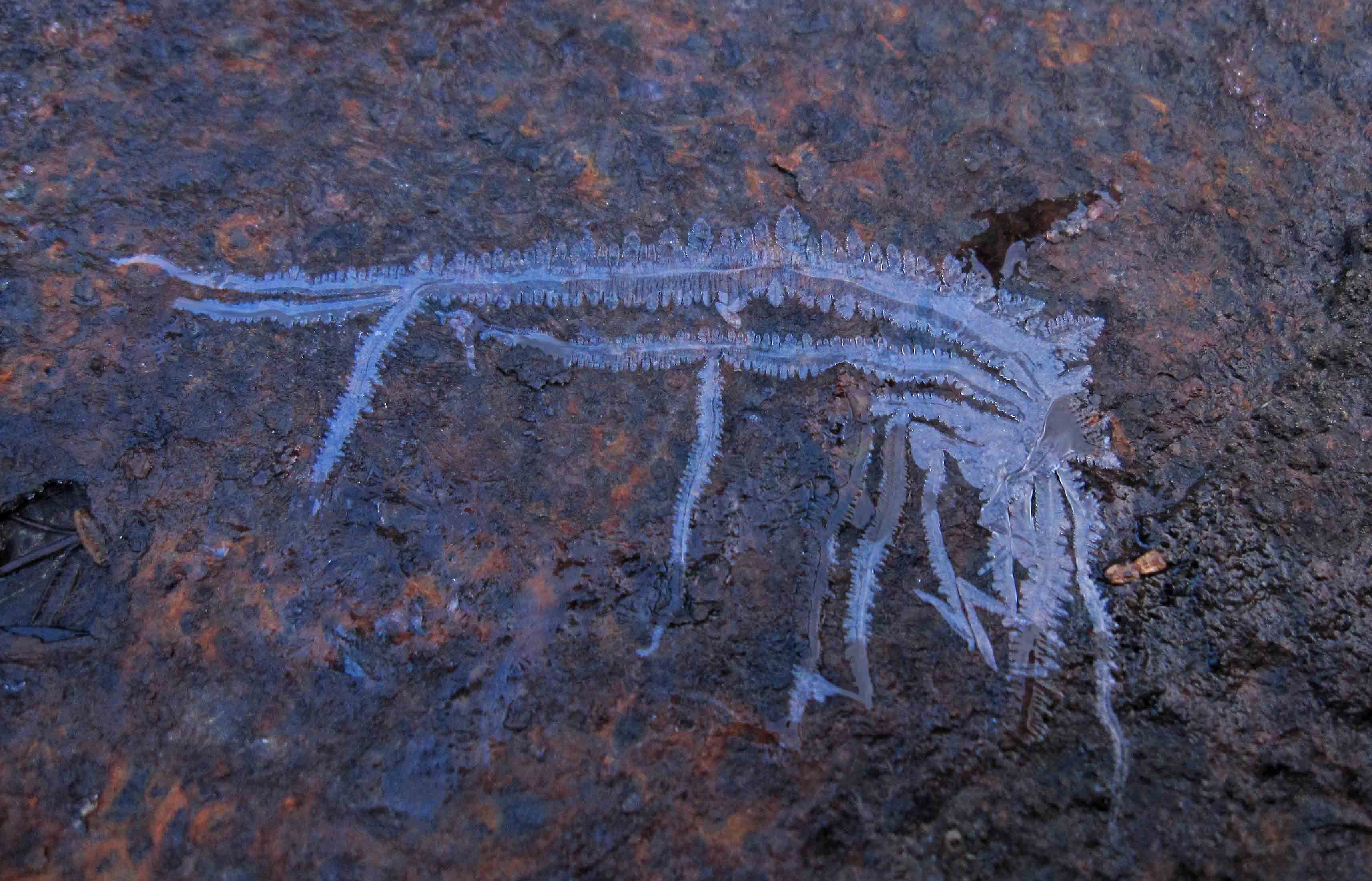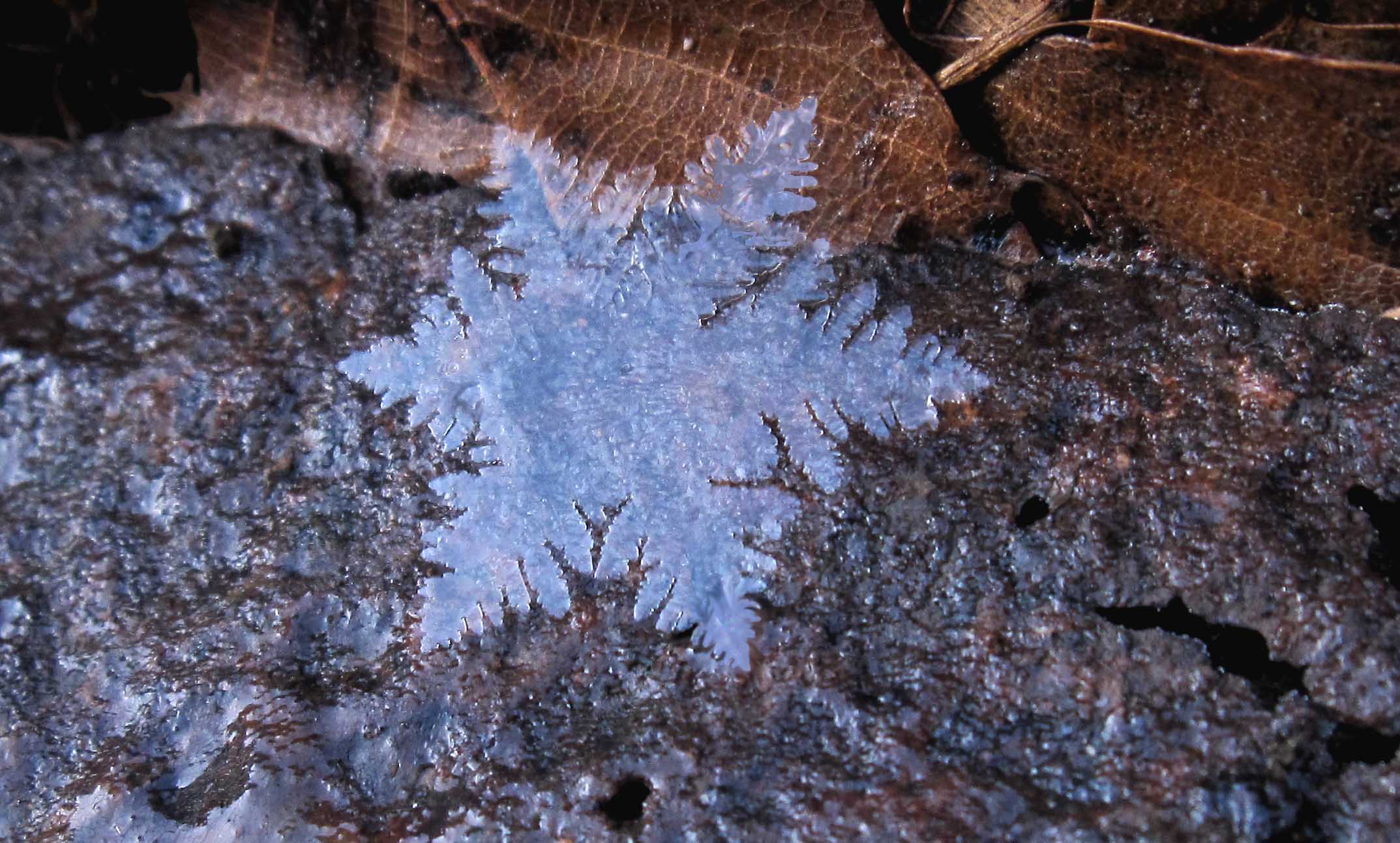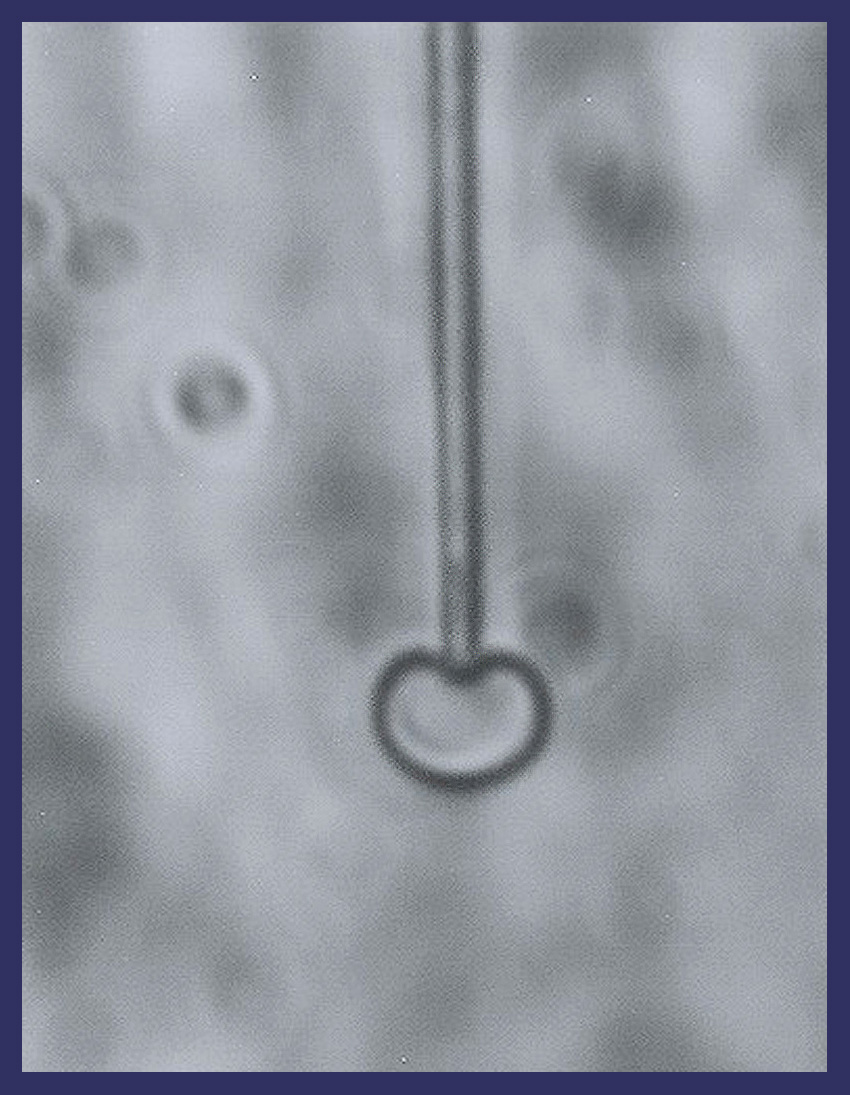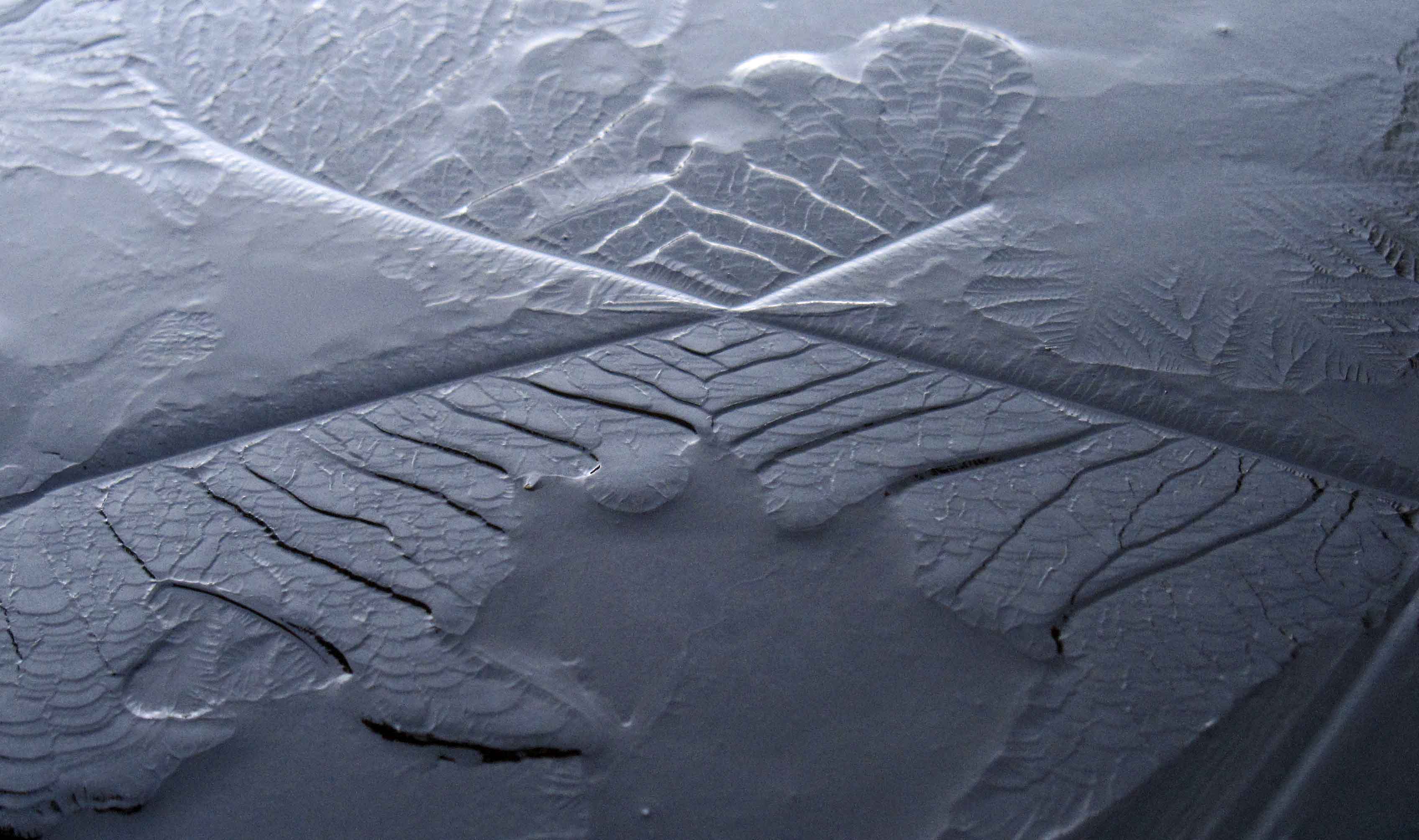Category: "Ice Science"
Like Seashells at a Seashore
January 30th, 2010This morning it just barely dipped below freezing, the first time in several days. Off I went to the usual black cars. And once again the frost to me looked like things I’d seen before. I decided to take a few pictures anyway, and once again I was surprised at what I saw in the zoomed images. To my eye, the site in the image below looked like small droplets that froze and then grew hoar.
But the camera revealed a little more variety. The site looks like a miniature seashore with a bunch of white shells of various shapes. The clumping of crystals is a little puzzling, as the close-ups below show no obvious resemblance to a frozen droplet. In some clumps, the hexagonal sides of the crystals are clear, in others, the crystals appear to be tilted up on end, such that their hexagonal sides are not shown in profile. In one case on the left, the crystals are rounded in outline, and some are not clumps at all, just a single crystal. (As with all images in this blog, a click will enlarge them.)
With my camera battery running low, I moved on to the tubs and rice fields.
Ice on the Rocks
January 27th, 2010On the morning of December 7 of 2008, I saw a small yet distinct white patch on the ground amongst the dirty brown crunchy soil-ice columns in a rice field. If I hadn’t been looking straight at it, I would have missed it. Crouching down and clearing away some of the surrounding dirt-ice columns, I found it to be a white ice column resting on a small pebble, unlike the surrounding brown columns that rested on the soil. You can see this pebble and ice at the upper left in the image below.
The white ice “cap” detached easily and cleanly from the pebble (See the above image, upper right). I could put the cap back on the pebble, and it would stay in place, fitting snugly.
Eyes and Dry Moats
January 22nd, 2010Though I appreciate seeing the old and familiar, when I venture outside on frosty mornings, I usually see at least three unexpected things. Three unexpected things before breakfast. A few days ago, the frost at first appeared more hoary than curvy, but when I peered over the top of a black SUV, I saw ice curves in the shape of an eye. Just for fun, I put an image of it next to a mirror-reversed copy, to give the following composite.
Call it the eyes of frost. Like me, you've probably seen curvy growth before, even if it didn't take the form of an eye. But let's venture into the eye of frost and notice something new: straight-segmented web-like growth.
I've never seen that before, and I never expected it.
The Maltese Cross in Pond Ice
January 21st, 2010A few days after my encounter with the pawprints and grey muck, one of the ponds did freeze over. After me and my camera spent about 30 minutes admiring this rare event, I went and ruined the complete glaze job by punching a hole in it. Although the top surface had lots of interesting curves and shallow grooves, the underside, only about 8-mm below, was flat and featureless. I suppose this is because the surface marking the melt-line (i.e., 0 degrees C) is flat. But when I put a piece of pond glaze between two polaroid sheets, with one polaroid 'crossed' to the other, I saw an odd sight.
The large black "X" that appears here is sometimes called the "Maltese cross". Elizabeth Wood, in her classic little book "Crystals and Light", calls it the "black cross". And when I looked up some cross shapes online, I thought the above figure looked more like the German "iron cross". Anyway, whatever you call it, it doesn't seem to fit the scene.
Strange Pawprints in the Ice
January 15th, 2010On account of the recent cold spell, I went up the hill behind us in search of a glazed-over pond. Ponds can have interesting freezing patterns and, if the ice is thick enough, a little excitement. I've never seen these ponds freeze, but then again, I've never thought it likely enough to warrant a visit in winter. The first two ponds I visited (technically, man-made reservoirs for flooding the rice fields) had ice only over a small section at one end. I had better luck with with a drained pond. This 'pond' looked more like a dirty mud pit, but I saw evidence of ice on one side. So, ignoring the warning signs (more on that later), I walked down and around to the icy end. From eye-level, and even from a crouch, this ice looked like snow.
But except for the holes that exposed the dirt underneath and the twiggy matter on top, the surface was smooth and level, like that of a glazed pond or puddle. Indeed, a partially glazed-over pond is probably what it had been. The whiteness was due to some fuzzy growth underneath that I could see in the large gaps (see the image below).
Snakeskin Frost and Other Curiosities
January 12th, 2010You can see a lot on just one black car. The nearly uniform appearance of white frost shows, upon closer inspection, a variety of forms. The first black car of yesterday morning didn’t seem so striking, and I considered passing it by. But, thinking of something that happened a few weeks ago, I hung around and took some pictures. You see, a few weeks ago, I discovered in my morning photos one picture that looked like snakeskin. It was the only one like it in my entire collection, but unfortunately a bit fuzzy. So, I swore thereafter to always look at the photos as I take them, then if something really new comes along, I can take many shots and hope that at least one is in good focus. Luckily, I stumbled upon the snakeskin frost on this car, but once again, only took one shot (alas - it also looks fuzzy). I guess I'll never learn.
If you click on the picture and zoom in, you'll see that the crystals are shaped like thin disks, laid down nearly flush against the car roof, like the scales on a snake’s skin. The bright crystals are the ones oriented to reflect the sky, whereas the dark crystals have a different orientation. These disks are tabular forms like the hexagonal plate, except without the flat, prismatic sides. But the same roof also had columnar forms:
Frost World
January 9th, 2010Whenever I am taking a picture on macro near the maximum close-up to an object, the aperture on my little Canon automatically sets to the maximum size, which means that the resulting images are in focus only at the center. Ever since I got the camera in late 2008, I've wondered how to get past this problem. In flash mode, the aperture decreases, extending the area of focus, but the image gets overexposed. Yesterday morning, I finally hit upon the (obvious) solution: set the camera to flash mode, but block the flash with aluminum foil. I had thought before that the result would be too dark, but with some white hoar in the picture, the image is bright enough. (Later I found that the image is fine, though a bit dark, even without hoar.) For a reason I don't understand, the exposure time is still relatively long with the flash on and the ISO value set low, so I probably need to better stabilize my little makeshift wooden 'tripod' and set a longer delay to allow vibrations enough time to damp out. Even so, the improvement gives me more room to explore in the miniature world of frost, which I call 'frost world'. For example, the image below, taken on the roof of a black car yesterday, shows some pyramid structures sticking up, a few valleys, straight ruts, straight streets, and parallel curving streets. The basic structure was laid down when the film of condensed water froze, which I call "film frost" (though it has no standard name) and then later hoar crystals grew up off the surface, adding a little white to the landscape. In this image, nearly all of the hoar is hexagonal.
When I took a picture of a frosty leave, the image in my viewfinder had an odd out-of-focus look (below), so I took a bunch more shots.
They Came From Out of the Tub
January 8th, 2010Last night it rained, but the skies cleared before morning, letting the air temperature drop to about 2 degrees C. The weather, it seemed, would be perfect for lacy white frost patterns on cars. But it didn't quite turn out that way. A little bit before sunrise, I went out on my rounds. I took a few pictures of ice on parked cars and then headed for the rice fields. Neither tub had ice, so I walked to the abandoned car on the other side of the roadway. Nothing of note there either, but in those few minutes a blade of ice had started across one tub. Soon there were several. With a stick, I went under one blade, lifted it up, and noticed the thin serrated fingers that had been growing into the water, hidden under the surface. The disturbance of the water surface caused the growing mesh of ice lines to drift, unattached to the tub walls. I don't see this in puddles. In the puddles, the ice is always anchored to the shore, presumably because the ice starts from the shore, where there are more things to nucleate from.
In the tub I saw a curvy piece and fished it out. Laid out on the rusted lid of a nearby barrel, the ice looked strange, like a fossil of some prehistoric creature.
The critter is about 3-4 inches head to tail and paper thin. As the crystal grew from liquid water, called 'melt' by material scientists, it is said to be "melt-grown". I call such crystals "puddle crystals". Anyway, soon ice was starting on the other tub. Out in the middle of an open patch of water, I saw a small hexagon. With a stick I tried lifting it out. I found that the central hexagon had six large branches that had been hiding just under the surface. But the crystal slipped off my stick and cut under the water's surface - never to be seen again. Needing something better than a stick, I found a piece of a plastic lid that had been left in a nearby ditch and tore off a piece. Then next time I saw a small, isolated hexagon, I lifted it out and put it on the barrel lid. See the photo below.
Though the central hexagon that I could see on the water was less than a half inch across, the full crystal was about one and a half inches across. Curious how the water would cover up all six branches symmetrically... Anyway, despite the large width of our 'puddle star', it too is paper thin. And being so flat and featureless on both sides, it evenly reflects the bluish skylight. The serrated pattern on the branches make this crystal a dendrite, like the dendritic snow crystal. But a puddle crystal grows much faster than a snow crystal because the melt (i.e., liquid water) is more densely packed with water molecules than the air from which snow grows. Also, when a snow crystal branch grows, it removes water vapor from the nearby air. This depletion of vapor is most severe near the base of the branches, and thus snow-crystal branches hardly widen - they mainly grow at the tip and at the tips of the side-shoots (called side-branches). But the melt is never depleted of water molecules, so the branches of puddle crystals keep widening until they merge. Another difference between puddle crystals and snow crystals is that puddle crystals viewed broadwise have a curving outline. The snow crystal usually has a polygonal outline, that is, made from straight lines.
- JN
Ice of Hearts
December 28th, 2009Back when I lived in Boulder CO, I worked with Charles Knight on developing a new way to grow ice crystals for experimental study. I knew that the problem with most methods was twofold: there were too many crystals too close together to be able to learn how each one behaved on its own, and the surface that held the crystal would influence the crystal’s growth. Charlie hit on a great way to eliminate the first problem: put some water in a small pipette (like a narrow, tapering straw) and freeze the water from the wide end. At the tip, which stuck out into a small observation chamber, ice would grow out as a single crystal. Unfortunately, the smallest pipette tip was about a millimeter in diameter, which is too large. I then tried using Dupont hollowfill fibers, which are about 20 times thinner – about as thick as fine human hair. But this was still too thick. So I started using glass capillaries, which I could heat with a small torch to draw down to sizes 100-1000 times thinner than the pipette – about as thin as small cloud droplets before they freeze into ice. We had our method. From the start we would see things that hadn’t been reported before. Some of these things we (or I) published, but most of the things still remain unpublished. One of them is the heart-shaped crystals. The photo below shows the tip of the capillary, which is about 10 times thinner than human hair, along with a thin heart-shaped crystal.
After the heart grew a little more, it developed into a hexagonal shape. But probably the most bizarre thing I saw occurred when I decided, just for kicks, to try to evaporate ice from the inside of a crystal by connecting the wide end of the capillary up to a vacuum pump.
Oddly Glazed Bathtub
December 26th, 2009I often see curious ice patterns on the surface of frozen water. On Christmas morning, I saw this strange pattern on one of the farmer's outdoor bathtubs. The foreground region looks a little like terraced rice fields on both sides of a mountain pass, but each terrace seems to have a structure like veins on a leaf. Indeed, the pattern within the 'mountain' on the right looks very much like a leaf. I have no idea how these patterns formed. The image is about 3 cm across.
-JN
